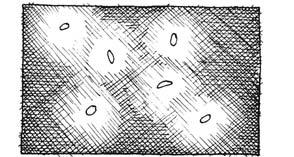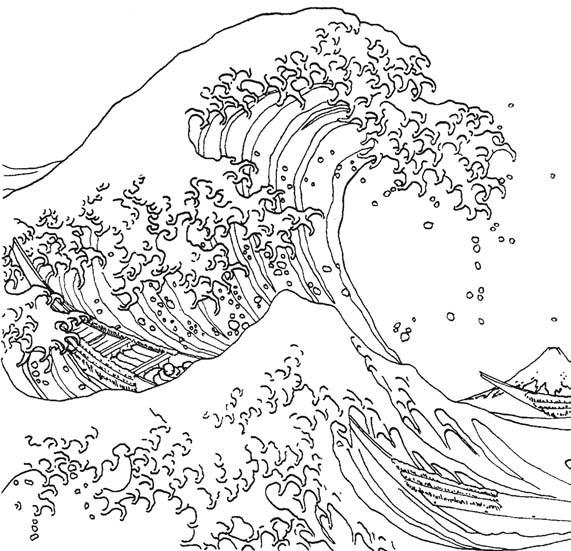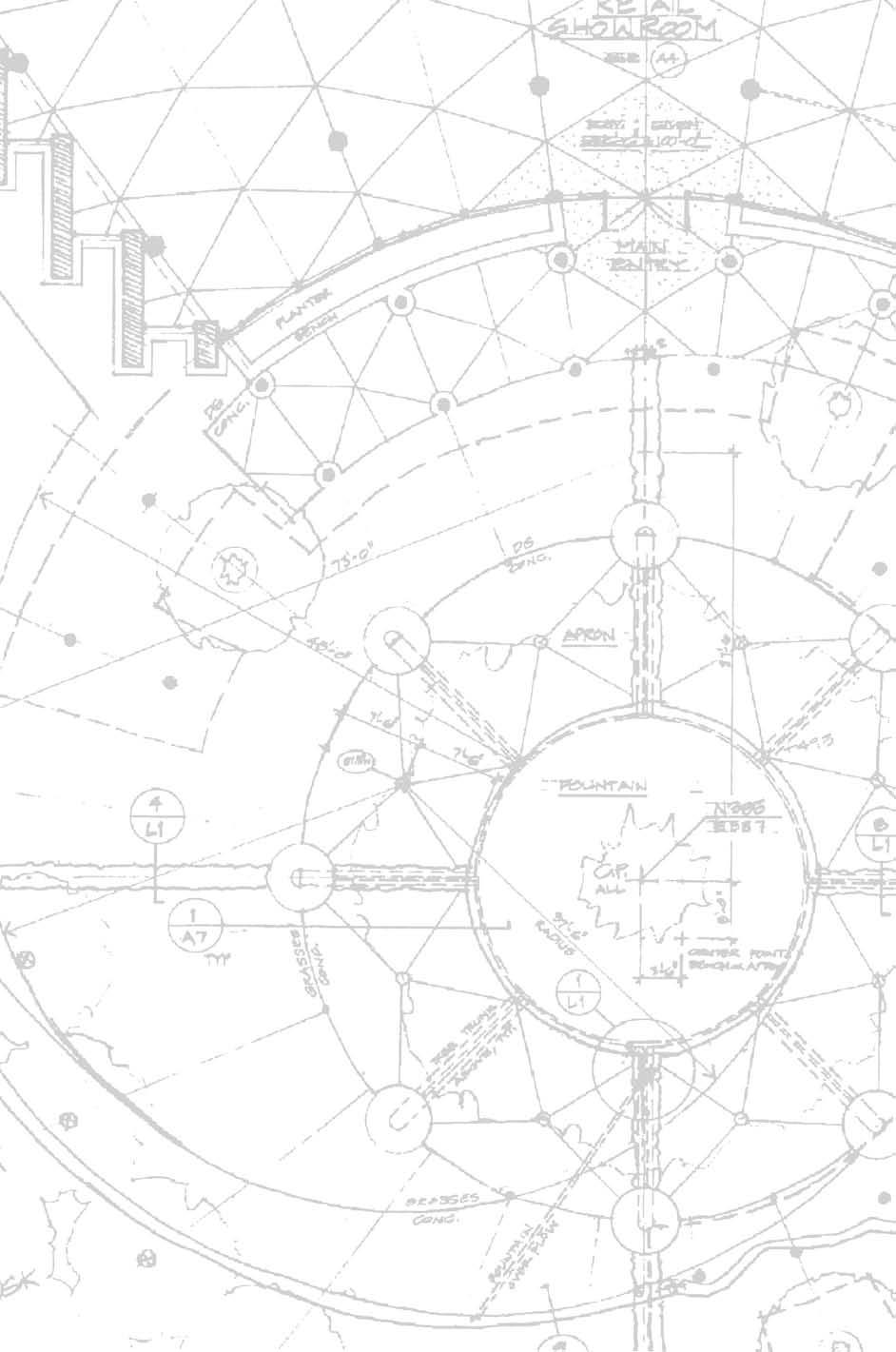
19 minute read
Nature’s Geometry
from Ecological Design
by TD Garden
Scale Linking
Consider a drop of rain. Hidden within it is an implicit history of places: water gathered from ancient fjords, alpine lakes, urban reservoirs, Antarctic ice, all running together in a single cycle, ever changing yet unitary. The flow of water in the biosphere links Australia to Greenland and Rocky Mountain springs to the Ganges. Other natural cycles bind us to the living world as they carry nutrients and trace minerals between earth, air, and water.
Advertisement
These cycles connect together phenomena at very different spatial scales (characteristic lengths). Jumping in scale a thousandfold at each step, we encounter a drop of water at a scale of one millimeter, a puddle at one meter, a lake at one kilometer, and the Antarctic ice at one thousand kilometers.
Nature’s processes are inherently scale linking, for they intimately depend on the flow of energy and materials across scales. The waste oxygen from blue-green algae is absorbed by a blue whale, whose own waste carbon dioxide feeds an oak tree. Global cycles link organisms together in a highly effective recycling system crossing about seventeen tenfold jumps in scale, from a ten-billionth of a meter (the scale of photosynthesis) to ten thousand kilometers (the scale of the Earth itself).
In a turbulent brook, eddies and whorls of all sizes grow and recede, send out tendrils, absorb their neighbors, and are in turn absorbed. Water is caught up in microscopic whirlpools and escapes to a larger scale, only to recede again to the microscopic. Scale-linking systems “imply a holism in which everything influences, or potentially influences, everything else—because everything is in some sense constantly interacting with everything else.”1 Nature is infused with the dynamical interpenetration of the vast and minute, an endless dervish mixing. Matter and
51
52 Bringing Design to Life
energy continually flow across scales, the small informing the large and the large informing the small.
We are predisposed to seeing processes at a single scale, refracted through a single discipline’s language, metaphors, and tools. In practice, this kind of perception is insufficient to capture the underlying phenomena. Suppose we were to determine the characteristic scale of acid rain. Is it the scale of a coal-fired power plant, spewing forth nitrogen and sulfur oxides? Or is it the scale of an individual house, feeding from that power plant? Is it the scale of an unhealthy lake, whose fish are dying as the water grows increasingly acidic? One might argue that the scale is regional, embracing an entire network of power plants. Canadians, angered by the disastrous impacts of American coal plants on their own lakes and forests, believe the scale of acid rain is international. Then again, perhaps we have missed the point: Isn’t the true scale of acid rain molecular, embedded in the intricate process chemistry of coal combustion?
It is clear that each of these possible scales of analysis has both some validity and some institutional support. Legions of experts study, respectively, pollution-control measures for power plants, energy-efficient homes, the ecology of lakes undergoing acidification, the atmospheric dynamics of pollution, the international legal implications of acid rain, and the chemistry of coal combustion. Acid rain involves the flow of various contaminants across many levels of scale. If we focus on a single scale, we miss the other scales, and hence miss opportunities to work across them in a unified way to address the problem.
The acid-rain example demonstrates that the ecological impacts of design activities cross scales and political jurisdictions. A house, a hydroelectric dam, and a wastewater system have impacts that are not neatly confined to a single scale. What we do at one scale has subtle impacts, both negative and positive, at many other scales. Scale linking reminds us of the wider environmental consequences of our designs.
Nature’s Geometry 53
Unless we work with nature’s own finely tuned scale-linking systems, we endanger the stability of life on this planet. We have already increased atmospheric carbon dioxide by one-fourth since preindustrial times, with important implications for the global climate. Even in remote regions, background levels of lead have increased by up to one thousand times.2 Our industry and agriculture already generate annual flows of heavy metals, sulfur, and other elements that are greater than their natural counterparts.
If we are to properly include ecological concerns within design, we must take seriously the challenge offered by scale linking. We need to discover ways to integrate our design processes across multiple levels of scale and make these processes compatible with natural cycles of water, energy, and materials.
In the 1920s, an eccentric Englishman named Lewis Richardson asked a deceptively simple question: What is the length of Britain’s coastline? As he looked at more and more detailed maps, he noticed new features. An apparently straight stretch of coastline on a coarse map would resolve itself into a series of coves, bays, headlands, and peninsulas on a finer map. Over many levels of map scales, the rugged coastline looked qualitatively similar.
While a square has no hidden detail at a finer scale, the British coastline constantly reveals new features as it is magnified (figure 4). Remarkably, it is made of fragments that resemble the whole. It is woven from a new kind of geometry that connects scales. In this geometry, forms at one scale resemble forms at another scale because the processes shaping form are essentially identical across many scales. This geometry provides a useful metaphor for our own attempts to bridge design disciplines that span very different scales.
In recent years, mathematicians have begun studying geometrical forms sharing many properties of the British coastline. While these idealized forms are immune to the subtle chance factors that give a natural
54 Bringing Design to Life
FIGURE 4. The coastline of Britain at successive scales of magnification
Nature’s Geometry 55
object its texture and irregularity, they provide simple and explicit models of geometries that link together multiple scales. Consider the construction of the Koch curve.
We start with a line segment.
Now we divide the segment into three parts.
Next, we build an equilateral triangle from the middle segment, erasing the base. We now have four segments, each with a length one-third of the original segment.
Now we apply the same process to each of the four new segments, adding a finer level of detail.
Applying the same process infinitely often, we obtain the Koch curve.
Each stage in the construction of the Koch curve adds subtler detail. The smallest existing level of scale forms a kind of skeleton for the
56 Bringing Design to Life
articulation of form at the next, even smaller, level of scale. At each stage, the structure is organized by pushing the middle third of each segment out into a triangle. Since each fragment of the Koch curve is organized by the same processes that shape the whole curve, each fragment resembles the whole curve. In fact, it is easy to see that the Koch curve is made up of four exact 3:1 copies of itself.
Both the coastline of Britain and the Koch curve manifest a remarkable kind of symmetry that explicitly links multiple scales. The symmetry is a simple one: The whole form is built up from subforms that echo the whole. This symmetry has appropriately been dubbed selfsimilarity, and forms possessing it are termed fractals. Self-similarity is a direct consequence of identical processes shaping form across many scales.
Fractal geometry is the geometry of scale linking. It connects a remarkable range of scales, from twig to tree, from rivulet to watershed. Even our own bodies are infused with fractal forms: “The lymph system, the small intestine, the lungs, muscle tissue, connective tissue, the folding patterns on the surface of the brain, the calyx filters in the kidney, and the design of the bile ducts—all show [fractal] scaling. This fractal design vastly increases the surface area available for the distribution, collection, absorption, and excretion of a host of vital fluids and dangerous toxins that regularly course through the body.”3 The available surface area of the lungs or brain increases when viewed at finer and finer scales, just as the length of the British coastline does. Since the chemical interactions critical for healthy biological functioning proceed more efficiently when a greater surface area is available, this evolved geometry is appropriate for its task. Convoluted fractal forms are valuable precisely because—unlike spheres—they have extremely high surface-to-volume ratios. In contrast with the standard forms of Euclidean geometry, fractal forms facilitate the flow of energy and materials across multiple scales.
In nature, geometries reflect and enhance underlying processes. In a
Nature’s Geometry 57
paper on the role of biological surfaces, the visionary biologist Paul Mankiewicz discusses the ability of the fractal root systems of plants to purify water.4 In conventional wastewater treatment systems, bacteria flow along with the water to be treated. They absorb substances in their immediate vicinity through relatively inefficient diffusion processes. In contrast, ecological wastewater treatment systems facilitate rich chemical exchanges on the surfaces of the roots (figure 5). The roots actively

Bacteria flow with the water and absorb nutrients through inefficient diffusion processes

A floating mat of water hyacinths showing the fractal structure of the root system

The fractal roots grow into the flow, creating a vast surface area for biological interactions and maximizing chemical gradients
FIGURE 5. Fractal roots and wastewater treatment
58 Bringing Design to Life
order the flow of chemical energy, facilitating the work of the microorganisms that inhabit them. Preliminary research indicates that the vast surface area provided by the root systems permits nutrient filtering to be performed extremely efficiently.
Nature’s geometry is an important organizing principle for ecological design. It determines the context for design, whether at the scale of a root system or an entire watershed. Over a century ago, Major John Wesley Powell, head of the U.S. Geological Survey, explicitly recognized this organizing principle in his suggestion to settle the arid West in a way that matched land allocations to the availability of water. Speaking to the Montana Statehood Convention in Helena on August 9, 1889, “he proposed to organize the new state of Montana into counties whose boundaries would be established by the divisions between hydrographic basins rather than by arbitrary political lines drawn on the map. Such basins, already being plotted out in Montana as in other parts of the west by his survey crews, were natural geographical and topographical unities; they might be given political and economic unity as well.”5 Powell foresaw the need to make water and homesteading laws reflect the fragile ecology of the West.
A project conducted in the San Francisco Bay Area provides a contemporary application of this principle. Geographer Josh Collins has been working with a mosquito abatement district to try to approximate the original fractal drainage fingers on a seventy-acre marsh on U.S. Navy land. After the marsh was disturbed by a road, it began to harbor some stagnant water, which served as a breeding ground for mosquitoes. In an attempt to eliminate this standing water, early mosquito abatement efforts focused on digging additional drainage ditches. These ditches—unaccompanied by an increase in tidal flux—were so effective that water no longer entered the upper reaches of natural channels. Portions of the upper channels filled in, creating the very potholes the mosquito abatement efforts were trying to avoid. As Collins notes, “The ditches previously created for mosquito reduction are not alleviat-
Nature’s Geometry 59
ing the problem. In fact, the marshes with the most extensive ditch networks often generate the most mosquitoes. This is because the number, size, and arrangement of these ditches were not determined in relation to marsh geomorphology and tidal hydrology.”6 By augmenting total tidal flow, severing drainage ditches connecting distinct drainage basins, and adding new ditches, Collins and colleagues have been able to partially restore the original fit between the geometry of the marsh’s drainage fingers and the character of the tidal flux. The new system is working well, and the marsh not only is mosquito-free but also is attracting shorebirds previously unknown at the site.
Geological processes operate in a self-similar way over a vast range of scales, producing a variety of fractal systems: coastlines, archipelagos, mountains, watershed drainages, fault lines, mineral deposits, and so on. Vegetation responds to these fractal landscape features, with each plant favoring a particular microclimate and set of soil conditions. Vegetation, in turn, is a major determinant of ecosystem structure and animal habitat. Fractal geological forms are ultimately reflected in fractal habitats.
Just as the earlier mosquito abatement efforts failed because they ignored the geometry of the marsh’s drainage fingers, current political and planning boundaries do not reflect the underlying structures and flows of landscapes. It is as if blood cells moving from one part of the body to another had to obtain travel visas. Our watersheds are divided up among towns, counties, states, and countries. The strip of cleared vegetation marking the Canada–U.S. border is visible in satellite photos, an ecologically meaningless line on a landscape otherwise filled with subtle harmonies.
Twenty-five years ago, landscape architect and planner Ian McHarg proposed a system of constraint maps that were intended to help planners identify ecologically sensitive areas. His plea for a more responsive method of environmental planning remains just as valid today: “Where planning does occur, its single instrument is zoning and by
60 Bringing Design to Life
this device political subdivisions are allocated densities irrespective of geology, physiography, hydrology, soils, vegetation, scenery, or historic beauty. The adoption of the ecological method would at least produce ...a structure of open space wherein nature performed work for man, or wherein development was dangerous.”7 Over time, perhaps we will learn to discern the integrities and continuities, the match of geometry and flow, inherent in a region’s geology, hydrology, soils, and vegetation.
Our ecological crises have resulted, in part, from a failure to match human flows of energy and materials to the limits of the landscape. The geometry of the landscape is manifested in the distribution of agricultural lands, minerals, wetlands, forests, and other primary resources. We have not followed this geometry. We have overstepped local limits and relied on far-flung ecological subsidies. A good example is provided by the vast water diversion projects that maintain life in desert towns like Los Angeles, Phoenix, and Las Vegas. While this refusal to acknowledge the limitations of place has many aspects, it is also a design issue. If we impose a Cartesian grid on a fractal landscape, settlements will be too large or small, flows will not be of a sensible scale, and we will compromise the ecological resources we depend on.
In contrast, by matching the flows on a landscape to its inherent geometry, we allow ecological patterns to work for us. We can use natural drainage instead of storm drains, wetlands instead of sewage treatment plants, and indigenous materials rather than imported ones. We can work toward a steady convergence of dwelling, design, and the geometry of place.
We are surrounded by a fractal landscape—clouds, mountains, river networks—and surely this has left us a fondness for the reconciliation and interweaving of multiple scales so characteristic of fractal geometry. This geometry teaches us a new kind of attentiveness, one that recognizes that “the landscape is the crucible in which living forms have evolved, and since the landscape crackles with fractals, the forms bred
Nature’s Geometry 61

FIGURE 6. Hokusai’s Great Wave, illustrating self-similar waves at many levels of scale
there are fractal as well.”8 This geometry reminds us that nature is constantly linking scales, bringing together the respiration of the blue whale and the photosynthesis of the oak in a single dance.
Creating a Design Dialogue Across Scales
Our present level of design integration across scales resembles the profusion of U.S. railroads in the mid-nineteenth century, each with its own gauge of tracks. The courageous cross-continental traveler would frequently transfer from one train to another since the gauges were incompatible. Architects, urban planners, industrial designers—design professionals of all stripes—are clinging to their own gauges, their own
62 Bringing Design to Life
scales of interest and expertise. Of course, each field does work at a different scale, and does incorporate certain specialized knowledge, but each must work within a common background of scale-linking proc esses that cross disciplinary boundaries. The challenge is to create a dialogue that links the insights of designers working at different levels of scale. Without a common gauge, a shared dialogue, we will continue to face the costs associated with rigidly segregated disciplines: mutual incomprehension and designs that work at cross-purposes.
In contrast, ecological design is not bound to a particular scale. It provides a way of uniting diverse design perspectives—and the different scales they represent—by testing them against strong ecological constraints. As we connect design across multiple scales, opportunities appear. For instance, we find that environmental planners can work not just for open space, but for critical wildlife corridors spanning biological reserves hundreds of kilometers apart. It is possible to design soaps that not only clean well but are biologically compatible with soils and streams. New glazing technologies, appropriate choices of building materials, and sensible solar siting can together eliminate the need for a conventional heating system. In each case, a wider design dialogue allows a deeper integration of design with nature.
The work of the Royal Commission on the Future of the Toronto Waterfront offers an excellent model for design across typically antagonistic professions and political jurisdictions. Since 1988, the commission has brought together diverse government agencies and citizens groups in an “ecosystem approach” to planning. According to the commission’s final report, Regeneration: Toronto’s Waterfront and the Sustainable City, this approach
•includes the whole system, not just parts of it •recognizes the ecosystem’s dynamic nature, presenting a moving picture rather than a still photograph of it
Nature’s Geometry 63
•uses a broad definition of environments—natural, physical, economic, social, and cultural •encompasses both urban and rural activities •is based on natural geographic units such as watersheds, rather than on political boundaries •embraces all levels of activity—local, regional, national, and international9
The Toronto watershed is afflicted with many different stresses. A very incomplete list would include emissions from factories and sewage treatment plants, agricultural runoff, household dumping of toxins in storm drains, acid rain and smog from the highly urbanized region, channelized creeks, habitat fragmentation from development, and deforestation. The commission has responded by recognizing a kind of “green infrastructure”:
What if we were to start with the demand for natural systems? How much land should be allocated to nature? How much to other kinds of open spaces? What ecological, aesthetic, urban design, and recreational functions can they fulfill?
This would lead to a different way of structuring urban form, using a fully linked, continuous “green infrastructure,” based on natural systems, and recognizing open space—not as an absence of buildings but as a land use in its own right. ... A green infrastructure may include natural habitat areas; land-forms such as bluffs, valleys, tablelands, beaches, and cliffs; aquifers and recharge areas; rural lands; heritage landscapes; parks, trails, and other open spaces; and archaeological sites.10
The notion of green infrastructure hints at a holistic approach to pollution, biodiversity, and watershed health, acknowledging that a watershed requires coordinated governance and interdisciplinary approaches. Moreover, the Regeneration report is surprisingly frank about the
64 Bringing Design to Life
inadequacies of existing political and planning jurisdictions in alleviating environmental problems that routinely transcend their boundaries. It states that “in the past, the parochial pressures of bureaucracies and representative governments have almost compelled them to be unresponsive to cross-jurisdictional issues. When everyone is in charge, no one is in charge.”11 The commission’s work is a promising attempt to create a meaningful dialogue among design disciplines.
The Natural Step Foundation in Sweden has taken on an even more ambitious project: creating a strong interdisciplinary scientific consensus on the root causes of the environmental crisis. The Natural Step has brought together scientists and professionals from dozens of fields in a search for shared understanding and vision. The results have been summarized in a beautiful, simply written booklet distributed to every household in Sweden. The Natural Step has deeply influenced policymakers, businesspeople, and ordinary citizens. Founder Dr. K.-H. Robèrt states the motivation for such a project:
Up to now, much of the debate over the environment has had the character of monkey chatter amongst the withering leaves of a dying tree—the leaves representing specific, isolated problems. We are confronted with a mass of seemingly insoluble questions. In the very midst of all this chatter about leaves, very few of us have been paying attention to the environment’s trunk and branches. They are deteriorating as a result of processes about which there is little or no controversy; and the thousands of individual problems that are the subject of so much debate are, in fact, manifestations of systemic errors that are undermining the foundations of society.12
Both the Toronto waterfront and Natural Step projects are dialogues that reflect the inherent scale linking of natural processes. They bridge the language, the attitudes, and the fears that have kept the various scientific and design disciplines apart. Ecological design is an invitation to a similar dialogue, for without it, we will continue to find only frag-
Nature’s Geometry 65
mented solutions that are just precursors to further problems. We will continue to destroy that which is whole. On the other hand, if we begin such a dialogue in good faith, we may begin to find designs nuanced enough to honor the diversity and complexity of life itself.
Notes
1. John Briggs, Fractals: The Patterns of Chaos: Discovering a New Aesthetic of Art, Science, and Nature (New York: Simon & Schuster, 1992), 21. 2. John Harte et al., Toxics A to Z: A Guide to Everyday Pollution Hazards (Berkeley and Los Angeles: Univ. of California Press, 1991), 333. 3. Briggs, Fractals, 124. 4. These comments rely on a manuscript version of Paul Mankiewicz’s paper “Biological Surfaces, Metabolic Capacitance, Growth, and Differentiation: A Theoretical Exploration of Thermodynamic, Economic, and Material Efficiencies in Fluid Purification Systems,” a 1993 report from the Center for Restoration of Waters, Falmouth, Mass. 5. Wallace Stegner, Beyond the Hundredth Meridian: John Wesley Powell and the Second Opening of the West (New York: Penguin Books, 1992), 315. 6. Vicki L. Kramer, Joshua N. Collins, and Charles Beesley, “Reduction of Salt Marsh Mosquitoes by Enhancing Tidal Action,” Proceedings of California Mosquito Vector Control Association (1992): 21. 7. Ian McHarg, Design with Nature (Garden City, N.Y.: Natural History Press, 1969), 161. 8. Briggs, Fractals, 36. 9. Royal Commission on the Future of the Toronto Waterfront, Regeneration: Toronto’s Waterfront and the Sustainable City: Final Report (Toronto: Queen’s Printer of Ontario, 1992), xxii. 10. Ibid., 78. 11. Ibid., xxii. 12. K.-H. Robèrt, “Non-Negotiable Facts as a Basis for Decision-Making,” a working paper for the Natural Step Foundation, Amiralitetshuset, Sweden, 1-2.
PART TWO
THE ECOLOGICAL DESIGN PROCESS









